Claude Skills: Your “I Know Kung Fu” Moment Has Arrived (Part 1 of 3)
You’re building your fifth Next.js app this month.
Time for authentication. Again.
You fire up Claude Code. “Build me email OTP authentication with JWT, password management, rate limiting, CSRF protection…”
Claude starts coding.
It looks good.
But wait – the JWT implementation is different from your last project. The rate limiting uses a different pattern.
The password hashing… is this bcrypt or argon2 this time?
Every. Single. App.
A different variation of the same feature.
Not because you want variety.
But because that’s how AI works – it gives you a solution, not your solution.
Until now.
.
.
.
The Problem That’s Been Staring Us in the Face
We’ve all been here.
You’ve built authentication for your SaaS app.
It’s perfect.
Production-tested.
Battle-hardened.
Next project comes along.
Same authentication needs.
But when you ask Claude Code to build it:
- Different JWT strategy (why are we using RS256 now?)
- Different database schema (wait, where’s the sessionVersion field?)
- Different security patterns (no rate limiting on the OTP endpoint?)
- Different file structure (why is auth logic scattered across 15 files?)
Sure, it works.
But it’s not your authentication system. The one you’ve refined over months. The one with all the edge cases handled.
It’s like having a master chef forget their signature recipe every time they walk into a new kitchen.
The real tragedy?
You have the perfect implementation.
It’s sitting right there in your last project. But there’s been no way to teach Claude Code your patterns, your architecture, your way of doing things.
Until Claude Skills changed everything.
.
.
.
Enter Claude Skills: The “I Know Kung Fu” Moment
Remember that scene in The Matrix?
Neo downloads kung fu directly into his brain. Instant mastery. No training montage required.
That’s Claude Skills.
But instead of martial arts, you’re uploading your battle-tested code patterns directly into Claude’s knowledge base.
Here’s what just became possible:
Before Claude Skills:
- “Build authentication” → Random implementation each time
- Hours of tweaking to match your standards
- Inconsistent patterns across projects
- The eternal “wait, how did I do this last time?” dance
After Claude Skills:
- “Use the authentication-setup skill” → Your exact implementation
- Same patterns, same structure, same security measures
- 10 minutes from zero to production-ready auth
- Perfect consistency across every project
This isn’t just about saving time. It’s about something much bigger.
.
.
.
The Authentication Skill That Changes Everything
Let me show you exactly what I mean.
I built a Next.js boilerplate with a complete authentication system:
- Email OTP with 6-digit codes via Resend
- JWT sessions (access + refresh tokens)
- Password management with bcrypt
- CSRF protection on all mutations
- Rate limiting per email/IP
- Audit logging for security events
- Whitelist-only email access
- PostgreSQL + Prisma ORM
This wasn’t a weekend hack.
This was weeks of refinement. Every edge case handled. Every security hole plugged.
Then I turned it into a Claude Skill.
Now watch what happens.
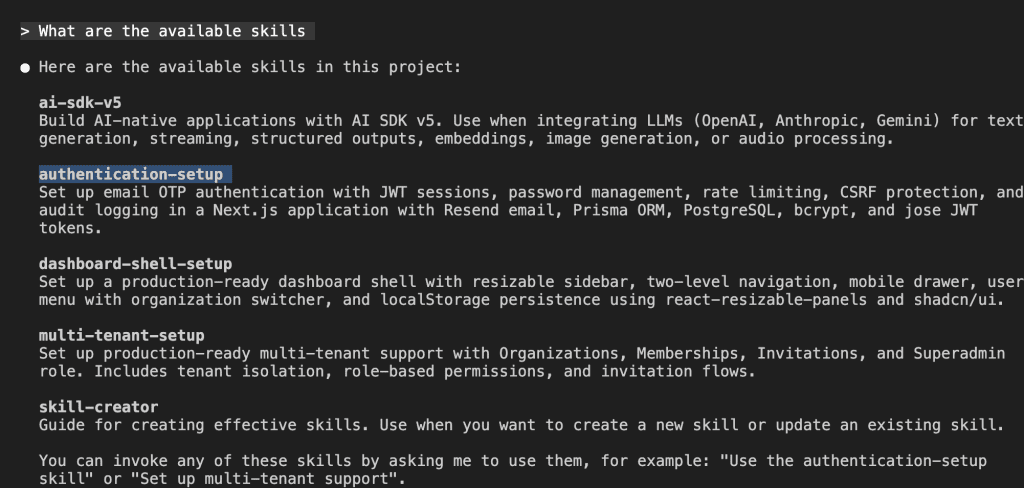
I simply ask: “What are the available skills?”
Claude shows me my arsenal:
- authentication-setup – Complete auth system with everything I mentioned
- multi-tenant-setup – Organizations, memberships, invitations
- dashboard-shell-setup – Production-ready dashboard with resizable sidebar
- ai-sdk-v5 – AI integrations for OpenAI, Anthropic, Gemini
Each skill is a complete feature set, ready to deploy.
.
.
.
The 10-Minute Authentication Implementation
Here’s where it gets interesting.
I tell Claude: “Please use the authentication-setup skill to setup the email OTP authentication for this app.”
I provide my PostgreSQL connection string and mention I need dev-only password login for testing.

Claude recognizes the skill and asks permission.
This is important – you maintain control over what gets implemented.
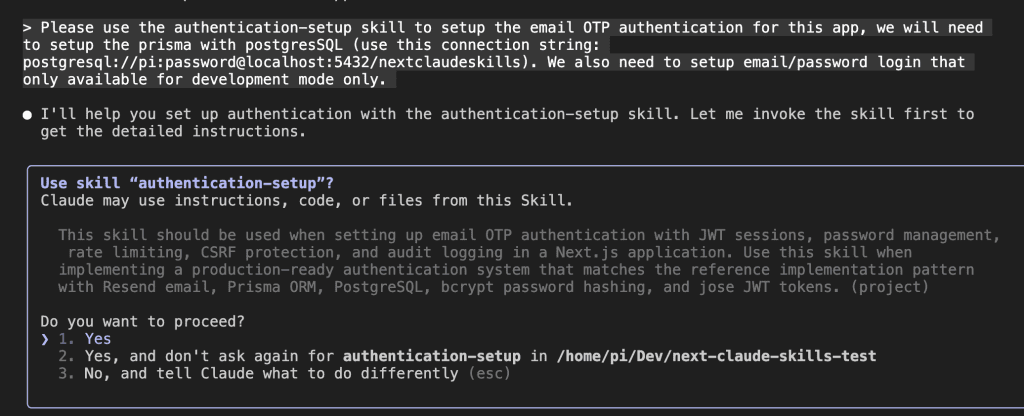
Watch as Claude:
- Examines your current project structure
- Reads the skill instructions
- Checks for existing code to avoid conflicts
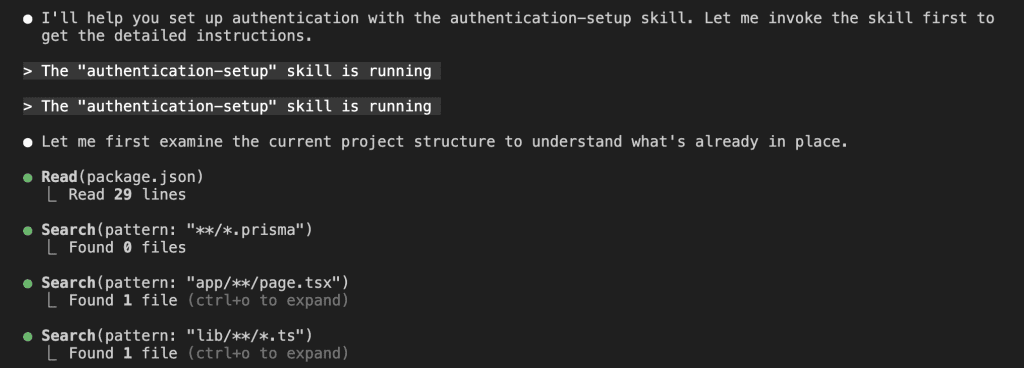
This isn’t blind copy-paste. It’s intelligent integration.
Here’s the genius part.

Claude asks configuration questions:
- Want to use shadcn/ui components or plain HTML?
- Have a Resend API key ready?
- Which additional features to include?
These aren’t random questions.
They’re part of the skill definition, ensuring the implementation matches YOUR specific needs for THIS project.
I select my preferences.
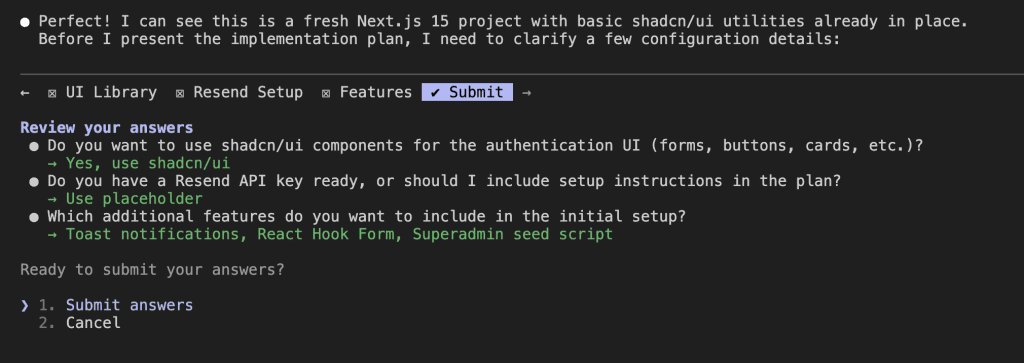
Notice how Claude provides options but also accepts custom inputs. The skill is flexible, not rigid.
Then Claude presents the complete implementation plan:
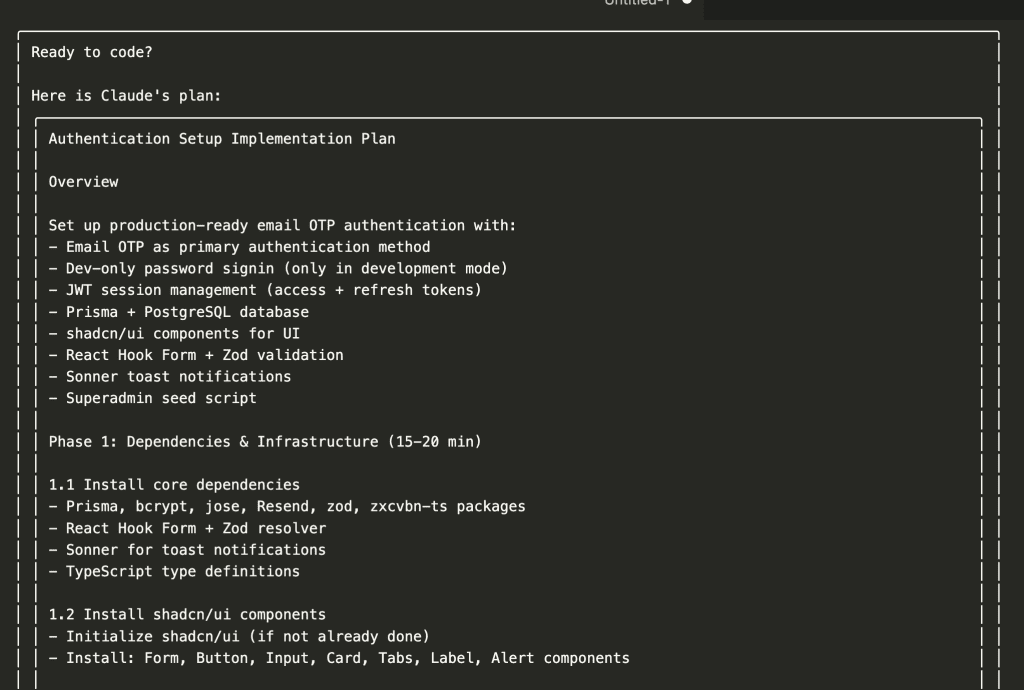
The plan includes:
- Phase 1: Dependencies & Infrastructure
- Phase 2: Core Library Files
- Phase 3: API Routes
- Phase 4: Middleware & Route Protection
- Phase 5: UI Implementation
- Phase 6: Database & Scripts
- Phase 7: Configuration & Documentation
Every. Single. Detail. Planned. Before writing any code.
.
.
.
Watching the Magic Happen
With the plan approved, Claude goes to work.
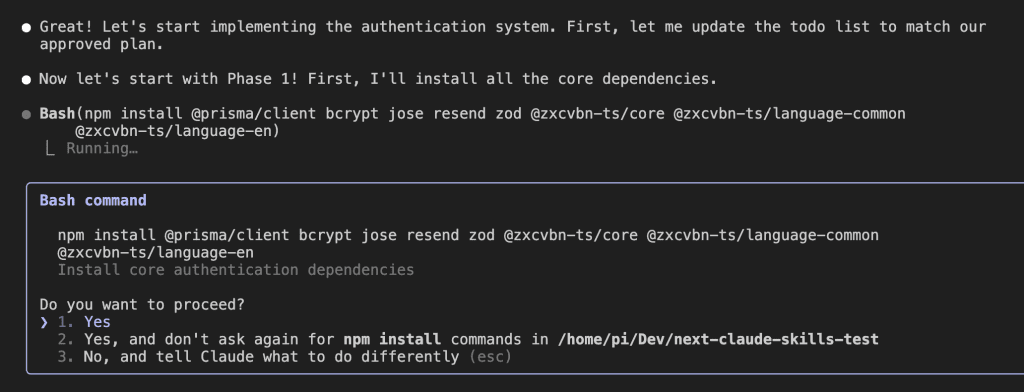
First, dependencies. Notice it installs exactly what my authentication system needs:
@prisma/clientfor databasebcryptfor password hashingjosefor JWT operationsresendfor emailszodfor validation@zxcvbn-tsfor password strength
Not a generic “auth package” in sight. These are my chosen tools.
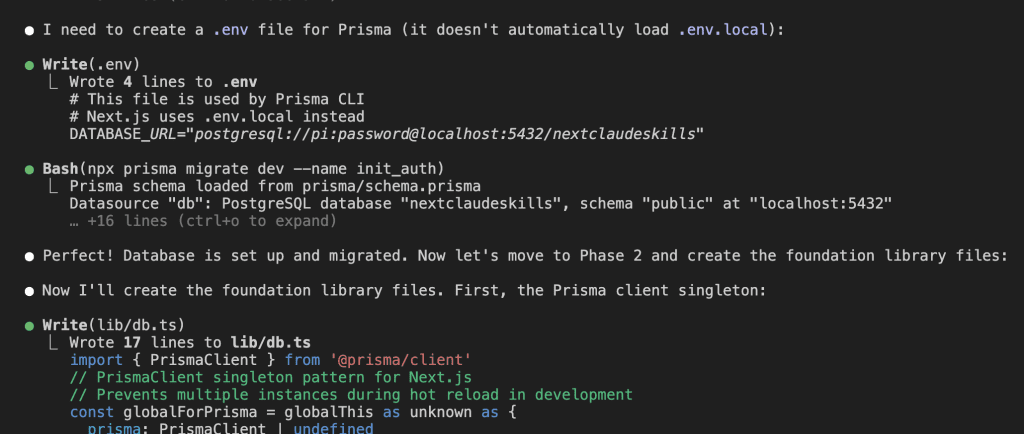
The Prisma schema matches my pattern exactly:
- User model with
sessionVersionfor instant session invalidation - OtpToken model with attempt tracking
- AuditLog for security events
This isn’t Claude’s guess at a schema.
This is MY schema.
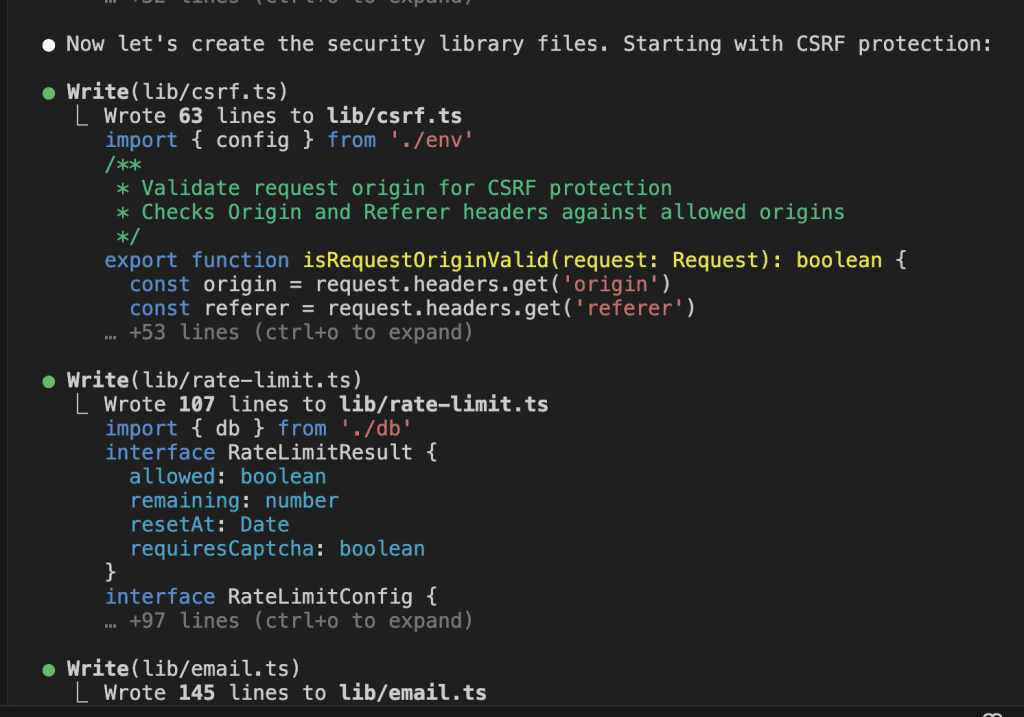
Watch as it creates:
lib/auth.ts– Core authentication logiclib/csrf.ts– CSRF protectionlib/rate-limit.ts– Rate limiting with database trackinglib/jwt.tsandlib/jwt-edge.ts– Separate JWT handlers for Node and Edge runtime
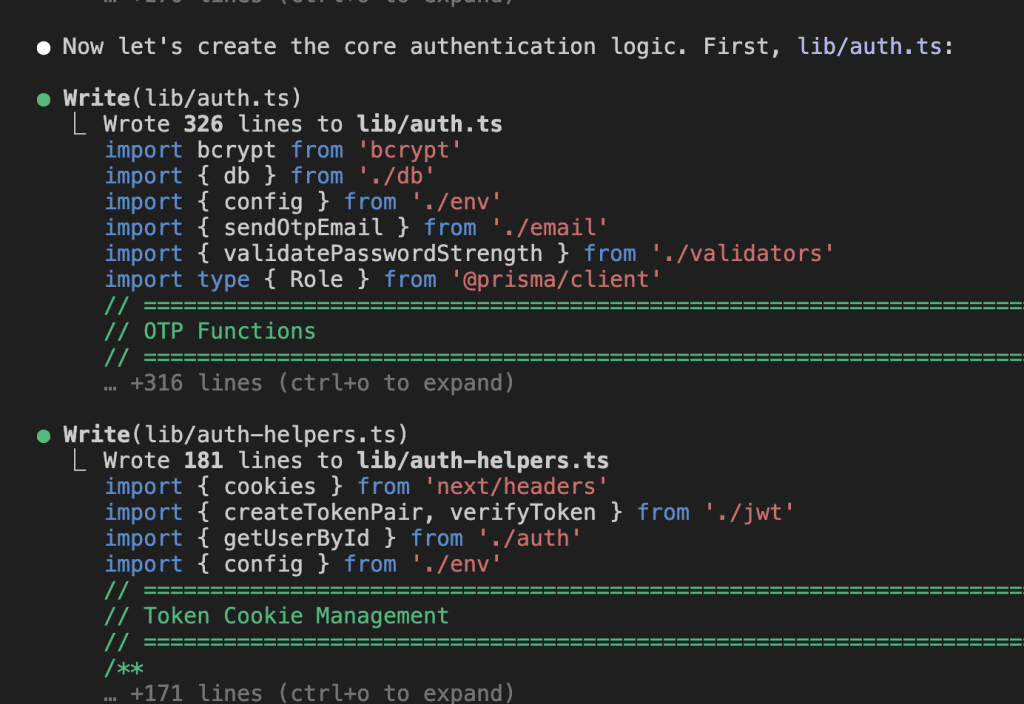
326 lines in lib/auth.ts alone. Every function, every pattern, exactly as I designed it.
The API routes follow my exact pattern:
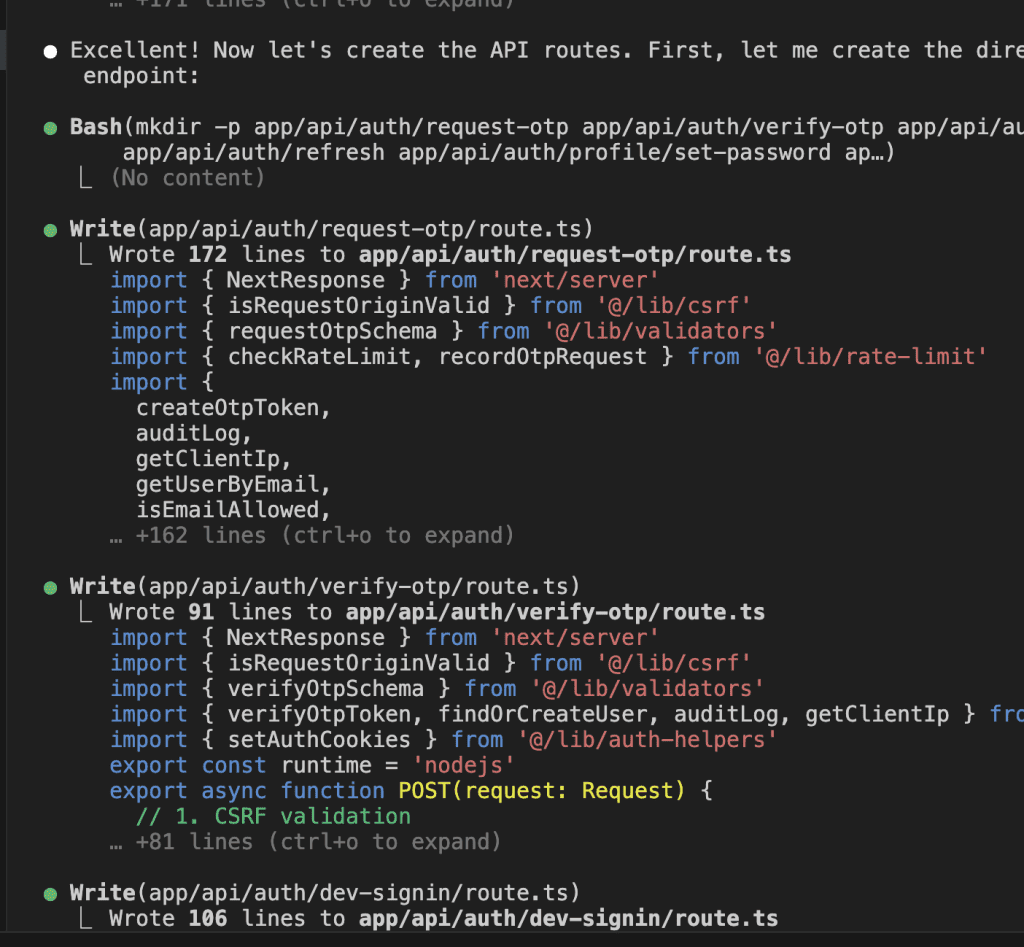
app/api/auth/
├── request-otp/route.ts
├── verify-otp/route.ts
├── dev-signin/route.ts
├── signout/route.ts
├── refresh/route.ts
└── profile/
├── set-password/route.ts
└── change-password/route.ts
Not scattered.
Not random.
My structure.
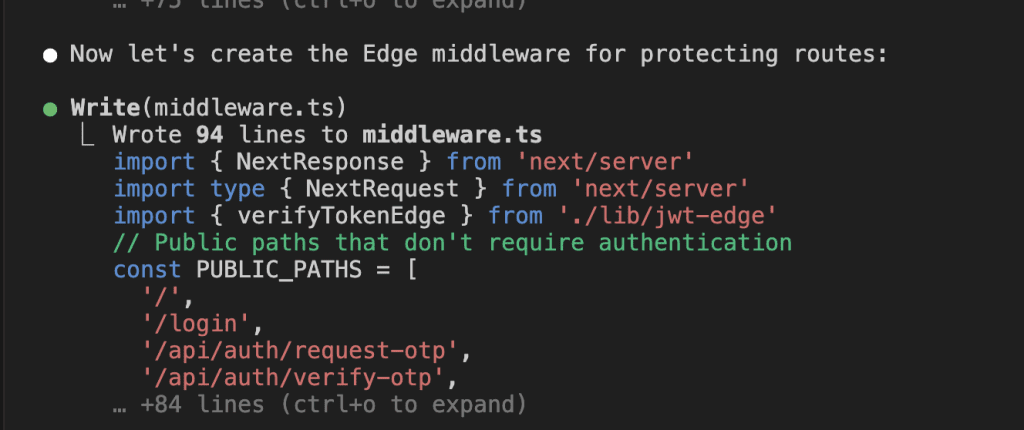
Edge middleware that:
- Verifies JWT without database calls (performance!)
- Protects
/dashboard/*and/settings/* - Redirects with
?next=parameter for smooth auth flow
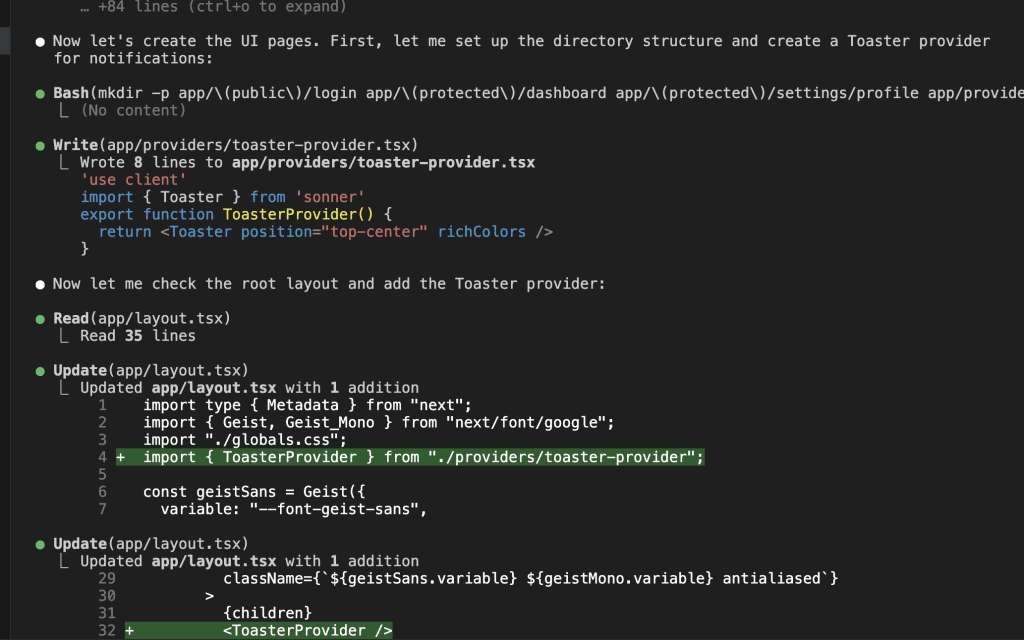
The login page with:
- Tabbed interface (OTP + Dev Password)
- React Hook Form + Zod validation
- Sonner toast notifications
- Proper loading states
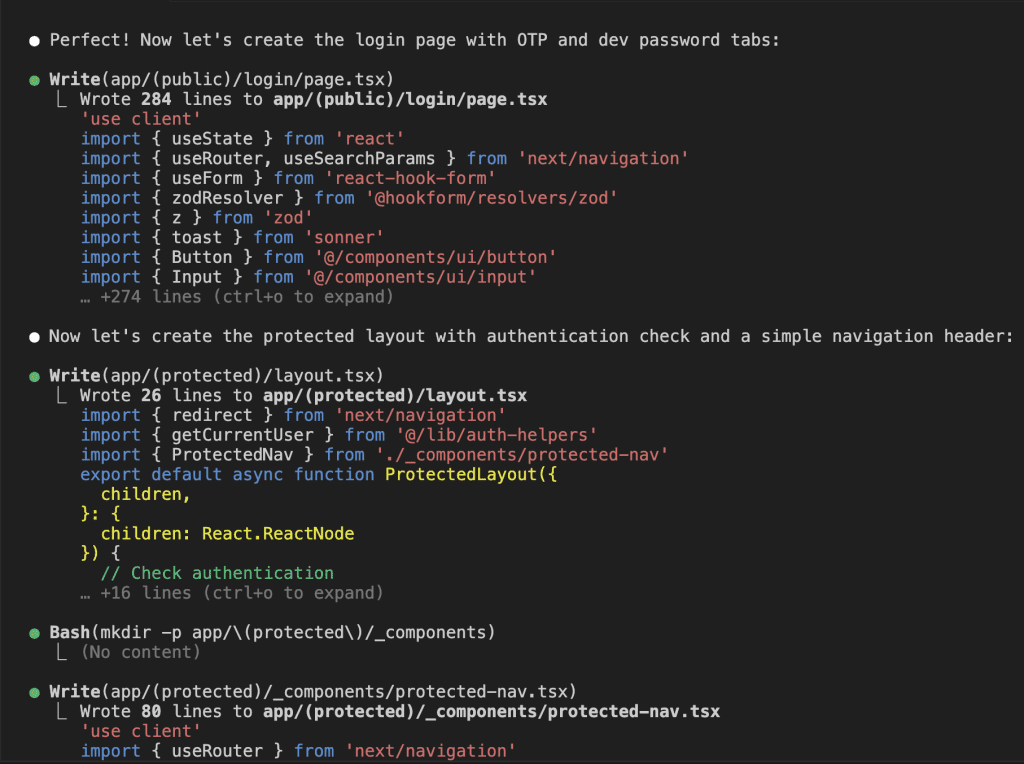
Protected layouts, profile pages, dashboard – all following the same patterns.
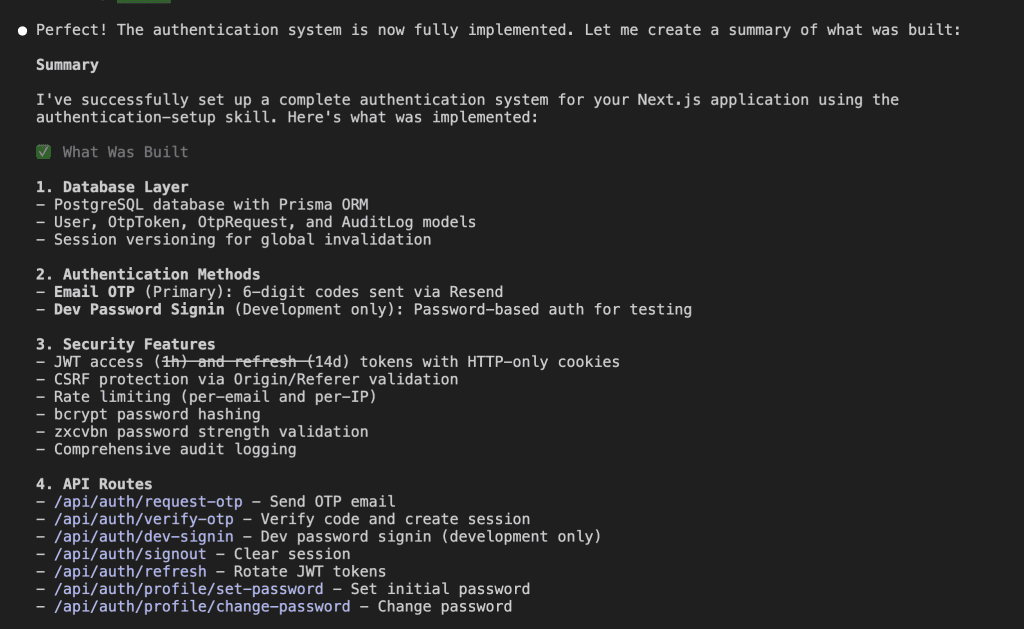
Done.
In under 10 minutes of actual implementation time.
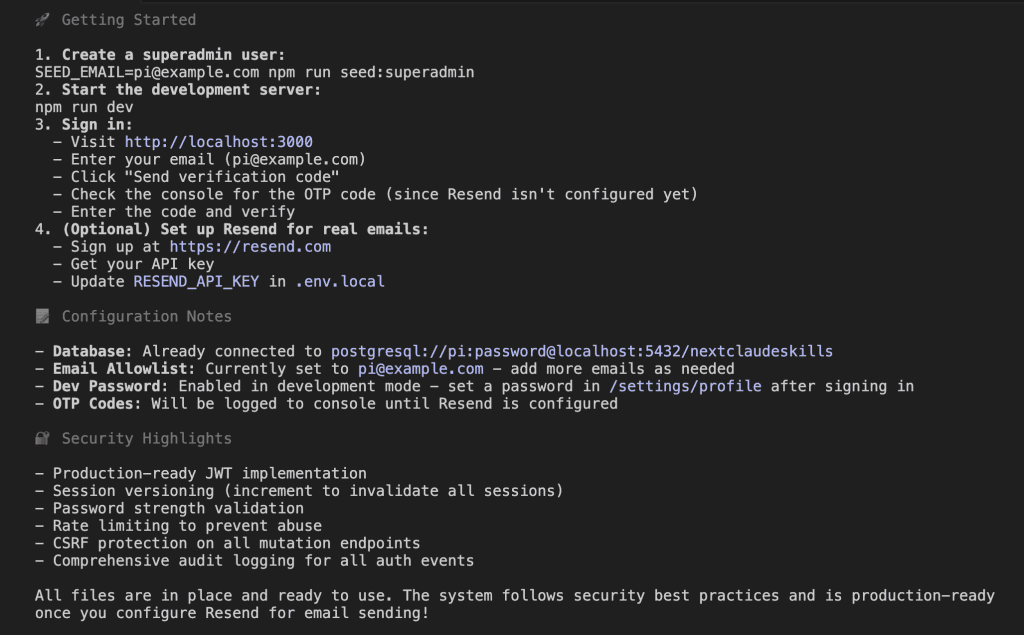
Claude even provides a getting started guide:
- Create superadmin:
SEED_EMAIL=you@example.com npm run seed:superadmin - Start dev server:
npm run dev - Visit http://localhost:3000
- Sign in with your email
Everything documented. Everything working.
.
.
.
The Proof: Side-by-Side Comparison
But does it actually match the original?
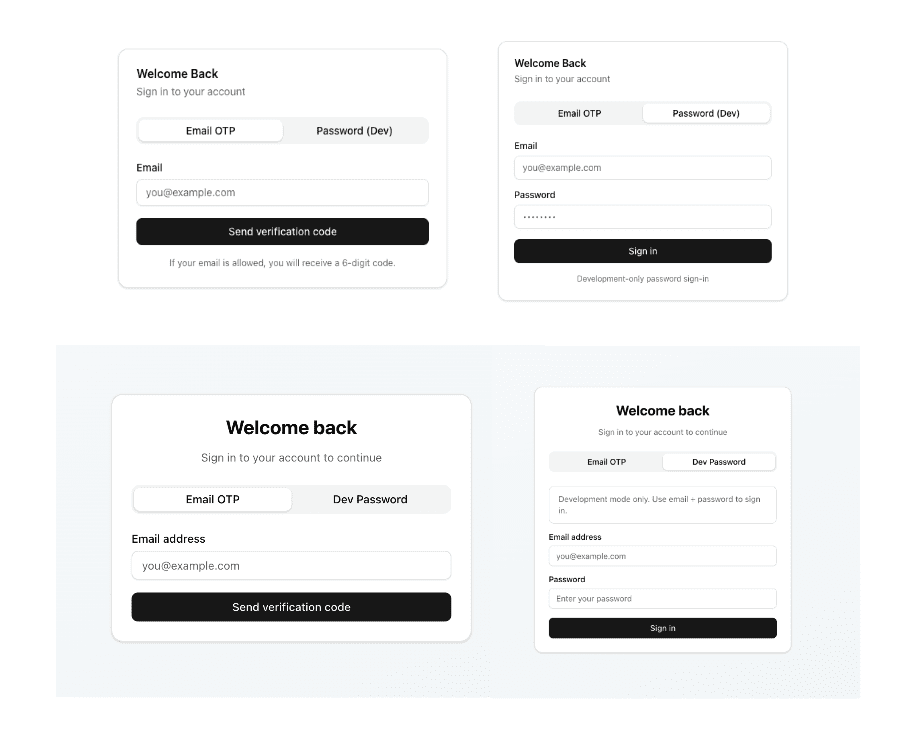
Look at those login pages.
The structure, the tabs, the form layout – virtually identical.
Some minor styling differences, but the core implementation?
Exact match.
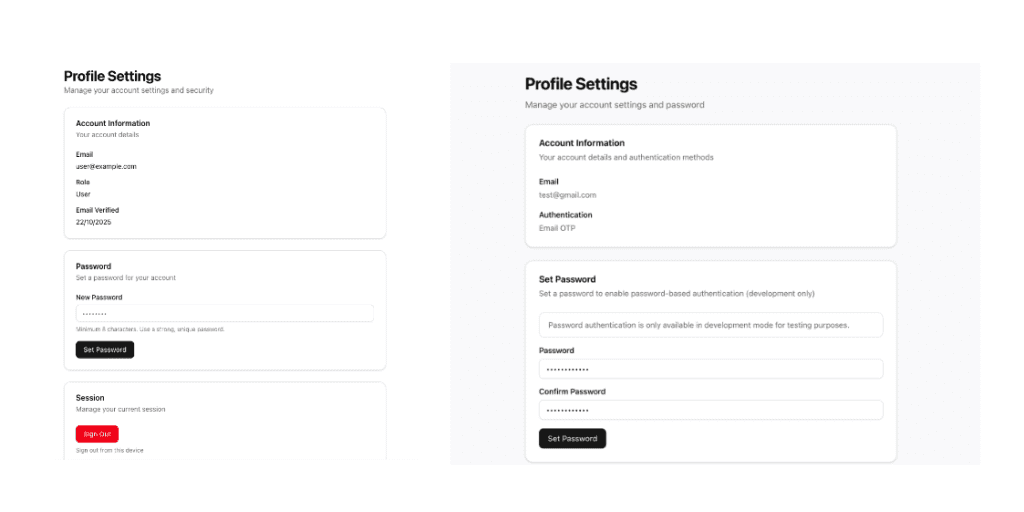
The profile pages tell the same story. Same sections, same password management, same session handling.
Here’s the kicker: The Claude Skills version actually improved on my original in some places. Cleaner code organization. Better error messages. More consistent styling.
The student became the master.
Then taught the next student to be even better.
Want techniques like these weekly?
Join The Art of Vibe Coding—short, practical emails on shipping with AI (without the chaos).
No spam. Unsubscribe anytime. Seriously.
.
.
.
Why This Changes Everything
This isn’t just about authentication.
Think bigger.
Every feature you’ve perfected can become a skill:
- Your payment integration with Stripe
- Your real-time notification system
- Your file upload handling
- Your admin dashboard layout
- Your API error handling patterns
- Your testing setup
Build once. Refine until perfect. Convert to skill. Deploy everywhere.
The compound effect:
1 perfected feature × 10 projects = 10 hours saved 10 perfected features × 10 projects = 100 hours saved 100 perfected features × Your entire career = …you do the math
But it’s not just time saved.
It’s consistency gained. It’s quality guaranteed. It’s your personal coding style, preserved and replicated perfectly.
.
.
.
The Hidden Benefits Nobody Talks About
Benefit #1: Your Code Patterns Become Your Coding Standard
No more “wait, which project had the good auth implementation?”
Your Claude Skills ARE your coding standard.
Benefit #2: Onboarding Becomes Trivial
New developer joins your team? “Here are our Claude Skills. Use them.”
Instant consistency.
Benefit #3: You Stop Reinventing Wheels
That perfect rate limiting implementation from 6 months ago?
It’s in your skill.
Ready to deploy.
Benefit #4: Your Skills Get Better Over Time
Find a bug in your auth flow? Fix it in the skill.
Every future project gets the improvement.
Benefit #5: You Can Share (Or Sell) Your Expertise
Those Claude Skills you’ve perfected?
They’re valuable. Share with your team. Open source them. Monetize them.
.
.
.
Your “I Know Kung Fu” Moment Awaits
Here’s what you need to understand:
Claude Skills aren’t just another AI feature. They’re the bridge between “AI that codes” and “AI that codes the way YOU code.”
It’s the difference between:
- A junior developer googling solutions
- A senior developer implementing YOUR solutions
Every pattern you’ve perfected.
Every architecture you’ve refined.
Every security measure you’ve battle-tested.
All of it can become a Claude Skill.
All of it can be replicated perfectly across every project you ever build.
The question isn’t whether you should start using Claude Skills.
The question is: which of your battle-tested features will you turn into a skill first?
In Part 2, I’ll show you exactly how to convert your existing codebase into a Claude Skill.
The process is simpler than you think, and the payoff is massive.
But for now, open that project with the perfect authentication system.
The one you’ve been copying manually to every new project.
It’s time to teach Claude YOUR kung fu.
P.S. – That authentication skill I demonstrated? It’s now deployed in 5 different production apps. Same code. Same patterns. Same security. Total implementation time across all 5 apps: under an hour. The old way would have taken days, and each would have been slightly different. That’s the power of Claude Skills.
P.P.S. – Part 2 drops next week: “How to Convert Your Battle-Tested Code Into Claude Skills.” I’ll walk you through turning your existing codebase into reusable skills, with specific examples and templates you can use immediately.
Leave a Comment